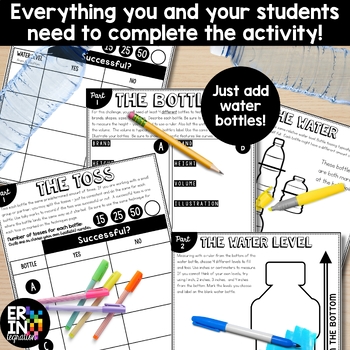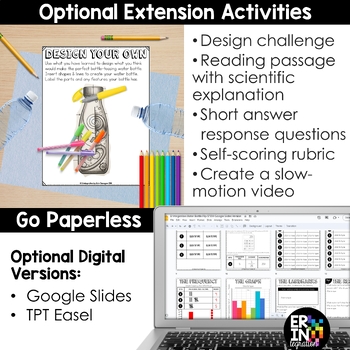Water Bottle Flip STEM Challenge + STEM Activity
- PDF
- Google Apps™
- Easel Activity

What educators are saying
Description
The ORIGINAL water bottle flip STEM activity and lab! Water bottle flip at school? Absolutely! Students will love this on-trend STEM challenge inspired by the popular YouTube water bottle flipping challenge where students toss a water bottle and attempt to land it straight up. Practice scientific method with some probability, fractions and data collection in the mix while having fun!
This self-paced, low-prep, project based learning water bottle flip STEM challenge is print-and-go. Each activity sheet guides students through the project.
STEM Challenge Overview:
Students will use the included visual directions, graphic organizers, charts, and activities to...
- Determine the best type of water bottle to use for flipping. Students will compare 4-8 different water bottles, develop a toss technique, collect data and calculate the success rate.
- Test the best water level to fill the bottle to have the best chance of landing their toss. Students will vary the water level, collect data and calculate the success rate.
- Create a frequency table, graph - either a line plot, dot plot, or bar graph (depending on what works best for your class), and calculate the mean successful tosses.
- Design the ideal bottle for flipping.
Materials Needed:
Just plastic water bottles! I suggest setting up a collection in the cafeteria for a week or so before doing the challenge to collect & reuse bottles.
ALSO includes:
- Self-score rubric
- Posters that explain the science behind the challenge.
- Printable water bottle labels for students to color and affix to "winning" bottles.
- Detailed teacher note page with video links to introduce the challenge.
- Visual step-by-step directions to film a slow motion video on the iPad of their tosses.
- Link to Google Slides paperless version of student pages
- TPT Easel Version
More STEM Challenges:
iPad and App Store are registered trademarks of Apple Inc. Google and Google Apps are trademarks of Google Inc. © 2015 Google Inc. All rights reserved. Erintegration is not affiliated with and has not been authorized, sponsored, or otherwise approved by Google Inc. or Apple Inc.






